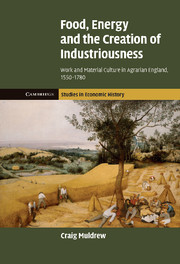 Food, Energy and the Creation of Industriousness
Food, Energy and the Creation of Industriousness Published online by Cambridge University Press: 04 February 2011
Memorandum that every one of these [servants] spent me in meat and drinke … one with another another xii l. a piece & a little above. Soe that I judge it were good (in such deare years) to keep as few servantes as a man possibly can, by any meannes convenient. To effect which I know no other meannes, but by putting forth a mans land to tillage, or at a rent, or else keeping them [the servants] at borde wages.
We have seen that labourers had to consume a lot of calories to do their work, and also that English agriculture generally supplied enough food in most years to maintain this consumption. In addition to this, most families managed to increase the value of their household goods as the price of food rose in the early seventeenth century. We now need to consider how labouring families afforded to feed themselves at such levels on the wages labourers were paid, especially when there was such a marked preference for foods which were more expensive per calorie such as wheaten bread, beer and meat. This is especially problematic for the period from 1550 to 1650, when nominal wages lagged significantly behind rising food prices.
As we saw in chapter 1, the most important work on estimating changes in real wages has been done by Phelps Brown and Hopkins and more recently by Gregory Clark.
To save this book to your Kindle, first ensure no-reply@cambridge.org is added to your Approved Personal Document E-mail List under your Personal Document Settings on the Manage Your Content and Devices page of your Amazon account. Then enter the ‘name’ part of your Kindle email address below. Find out more about saving to your Kindle.
Note you can select to save to either the @free.kindle.com or @kindle.com variations. ‘@free.kindle.com’ emails are free but can only be saved to your device when it is connected to wi-fi. ‘@kindle.com’ emails can be delivered even when you are not connected to wi-fi, but note that service fees apply.
Find out more about the Kindle Personal Document Service.
To save content items to your account, please confirm that you agree to abide by our usage policies. If this is the first time you use this feature, you will be asked to authorise Cambridge Core to connect with your account. Find out more about saving content to Dropbox.
To save content items to your account, please confirm that you agree to abide by our usage policies. If this is the first time you use this feature, you will be asked to authorise Cambridge Core to connect with your account. Find out more about saving content to Google Drive.